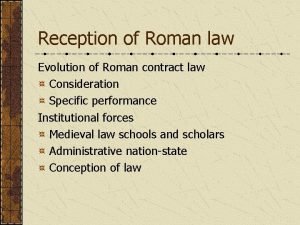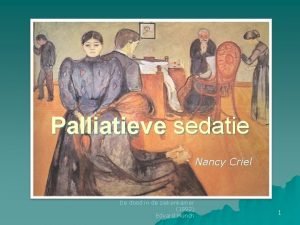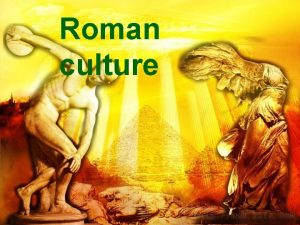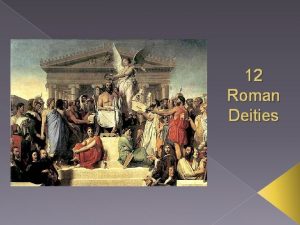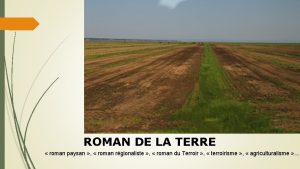Roman Godenpijler Museum Het Valkhof Nijmegen the Netherlands























































































































- Slides: 119



Roman Godenpijler , Museum Het Valkhof Nijmegen, the Netherlands

• Anonymous Orpheus Taming Wild Animals Roman marble mosaic, A. D. 194; Eastern Roman Empire, near Edessa Dallas Museum of Art Orpheus was a legendary musician, poet, and prophet in ancient Greek religion and myth. The major stories about him are centered on his ability to charm all living things and even stones with his music, his attempt to retrieve his wife, Eurydice, from the underworld, and his death at the hands of those who could not hear his divine music. As an archetype of the inspired singer, Orpheus is one of the most significant figures in the reception of classical mythology in Western culture, portrayed or alluded to in countless forms of art and popular culture including poetry, opera, and painting. For the Greeks, Orpheus was a founder and prophet of the socalled "Orphic" mysteries. He was credited with the composition of the Orphic Hymns, a collection of which survives. Shrines containing purported relics of Orpheus were regarded as oracles. Some ancient Greek sources note Orpheus's Thracian origins.

Orpheus with the lyre and surrounded by beasts, Christian and Byzantine Museum, Athens. Orpheus with wild animals, House of Orpheus, Paphos. , 3 rd c. AD

Orpheus surrounded by animals, Roman Mosaic Museo archeologico regionale di Palermo Orpheus surrounded by animals Imperial Roman Mosaic, C 4 th AD, from Philippopolis Shahba Museum, Syria

Savery Roelant, Orpheus with beasts and birds, 1622, The Fitzwilliam Museum, University of Cambridge, UK.


Károly Ferenczy, Orpheus, 1894, Hungarian National Gallery

Venetian artist, Orpheus , c. 1515 National Gallery of Art, Washington, DC

Pirro Ligorio Orpheus Charming the Beasts

Alessandro Varotari, Orpheus enchanting the animals, 17 th century, Museo del Prado, Madrid Michael Willmann Orpheus playing on harp (detail), c. 1670 National Museum in Wrocław

Marc Chagall, Orpheus, 1969 Marc Chagall, Orpheus playing, 1970

The earliest literary reference to Orpheus is a two-word fragment of the sixth-century BC lyric poet Ibycus: onomaklyton Orphēn ("Orpheus famous-of-name"). He is not mentioned in Homer or Hesiod. Most ancient sources accept historical existence; Aristotle is an exception. Pindar calls Orpheus "the father of songs” and identifies him as a son of the Thracian king Oeagrus and the Muse Calliope: but as Karl Kerenyi observes, "in the popular mind he was more closely linked to the community of his disciples and adherents than with any particular race or family". Greeks of the Classical age venerated Orpheus as the greatest of all poets and musicians: it was said that while Hermes had invented the lyre, Orpheus perfected it. Poets such as Simonides of Ceos said that Orpheus' music and singing could charm the birds, fish and wild beasts, coax the trees and rocks into dance, and divert the course of rivers. He was one of the handful of Greek heroes to visit the Underworld and return; his music and song even had power over Hades. Some sources credit Orpheus with further gifts to mankind: medicine, which is more usually under the aegis of Aesculapius; writing, which is usually credited to Cadmus; and agriculture, where Orpheus assumes the Eleusinian role of Triptolemus as giver of Demeter's knowledge to mankind. Orpheus was an augur and seer; practiced magical arts and astrology, founded cults to Apollo and Dionysus and prescribed the mystery rites preserved in Orphic texts. In addition, Pindar and Apollonius of Rhodes place Orpheus as the harpist and companion of Jason and the Argonauts. Orpheus had a brother named Linus who went to Thebes and became a Theban. Strabo (64 BC – c. 24 AD) presents Orpheus as a mortal, who lived and died in a village close to Olympus. "Some, of course, received him willingly, but others, since they suspected a plot and violence, combined against him and killed him. " He made money as a musician and "wizard" – Strabo uses agurteuonta (αγυρτεύοντα), also used by Sophocles in Oedipus Tyrannus to characterize Teiresias as a trickster with an excessive desire for possessions. Agurtēs (αγύρτης) most often meant charlatan and always had a negative connotation. Pausanias writes of an unnamed Egyptian who considered Orpheus a magician (mageuse (μάγευσε).

Roelandt Savery, Orpheus, 1628, The National Gallery, London

Sebastian Vrancx, Orpheus and the Beasts, circa 1595, Galleria Borghese, Rome

Anonymous, Orpheus and the Beasts, 17 th century

Orpheus mosaic found in the Roman villa at Woodchester

Hans Leu the Younger Orpheus and the animals, 1519 Kunstmuseum Basel

Gillis d'Hondecoeter, Orpheus Charming the Animals, 1631

Franz von Stuck, Orpheus, 1891

Several etymologies for the name Orpheus have been proposed. A probable suggestion is that it is derived from a hypothetical PIE verb *orbhao-, "to be deprived", from PIE *orbh-, "to put asunder, separate". Cognates would include Greek orphe, "darkness”, and Greek orphanos, "fatherless, orphan", from which comes English "orphan" by way of Latin. Orpheus would therefore be semantically close to goao, "to lament, sing wildly, cast a spell", uniting his seemingly disparate roles as disappointed lover, transgressive musician and mystery-priest into a single lexical whole. The word "orphic" is defined as mystic, fascinating and entrancing, and, probably, because of the oracle of Orpheus, "orphic" can also signify "oracular". Fulgentius, a mythographer of the late 5 th to early 6 th century AD, gave the unlikely etymology meaning "best voice, " "Oraia-phonos”. A Renaissance woodcut of Orpheus with his Lute

BASSANO, Francesco, Orpheus Charming the Animals

CUYP, Aelbert, Orpheus with Animals in a Landscape, c. 1640, Private collection

Henry Ryland The Young Orpheus , 1901 Torre Abbey, Torquay, Devon, England

BRONZINO, Agnolo Cosimo I de' Medici as Orpheus, 1537 -39 Museum of Art, Philadelphia

Briton Riviere, Orpheus, 1874

Paulus Potter, Orpheus Charming the Beasts , 1650, Rijksmuseum, Amsterdam

הארגונאוטים )חבורת הגיבורים שהשתתפו במסע החיפוש של יאסון אחר גיזת הזהב בספינה ארגו( צרפו . את אורפיאוס אליהם במסעם כדי שישקיט בשירתו את גלי הים ויחזק את רוחם של הספנים The Argonautica (Greek: Ἀργοναυτικά) is a Greek epic poem written by Apollonius Rhodius in the 3 rd century BC. Orpheus took part in this adventure and used his skills to aid his companions. Chiron told Jason that without the aid of Orpheus, the Argonauts would never be able to pass the Sirens—the same Sirens encountered by Odysseus in Homer's epic poem the Odyssey. The Sirens lived on three small, rocky islands called Sirenum scopuli and sang beautiful songs that enticed sailors to come to them, which resulted in the crashing of their ships into the islands. When Orpheus heard their voices, he drew his lyre and played music that was louder and more beautiful, drowning out the Sirens' bewitching songs. Russell Flint , The Argonauts


The most famous story in which Orpheus figures is that of his wife Eurydice (sometimes referred to as Euridice and also known as Agriope). While walking among her people, the Cicones, in tall grass at her wedding, Eurydice was set upon by a satyr. In her efforts to escape the satyr, Eurydice fell into a nest of vipers and suffered a fatal bite on her heel. Her body was discovered by Orpheus who, overcome with grief, played such sad and mournful songs that all the nymphs and gods wept. On their advice, Orpheus travelled to the underworld and by his music softened the hearts of Hades and Persephone (he was the only person ever to do so), who agreed to allow Eurydice to return with him to earth on one condition: he should walk in front of her and not look back until they both had reached the upper world. He set off with Eurydice following, and, in his anxiety, as soon as he reached the upper world, he turned to look at her, forgetting that both needed to be in the upper world, and she vanished for the second time, but now forever. The story in this form belongs to the time of Virgil, who first introduces the name of Aristaeus (by the time of Virgil's Georgics, the myth has Aristaeus chasing Eurydice when she was bitten by a serpent) and the tragic outcome. Other ancient writers, however, speak of Orpheus's visit to the underworld in a more negative light; according to Phaedrus in Plato's Symposium, the infernal gods only "presented an apparition" of Eurydice to him. Ovid says that Eurydice's death was not caused by fleeing from Aristaeus but by dancing with naiads on her wedding day. In fact, Plato's representation of Orpheus is that of a coward, as instead of choosing to die in order to be with the one he loved, he instead mocked the gods by trying to go to Hades and get her back alive. Since his love was not "true"—he did not want to die for love—he was actually punished by the gods, first by giving him only the apparition of his former wife in the underworld, and then by being killed by women. The story of Eurydice may actually be a late addition to the Orpheus myths. In particular, the name Eurudike ("she whose justice extends widely") recalls cult-titles attached to Persephone. The myth may have been derived from another Orpheus legend, in which he travels to Tartarus and charms the goddess Hecate.

Nicolas Poussin, Landscape with Orpheus and Eurydice, 1648, Musée du Louvre, Paris

Nicolas Poussin Orpheus and Eurydice, Detail Musée du Louvre, Paris

Maurice Denis, Orpheus and Eurydice, 1910, Minneapolis Institute of Arts

Maurice Denis, Orpheus and Eurydice in the spring, c. 1905

J P Pequignot , Landschap with Orpheus & Eurydice , 1802

Louis Ducis, Orpheus & Eurydice, 1825.

Eugène Ferdinand Victor Delacroix, Orpheus and Eurydice, 1862, Spring from a series of the Four Seasons, São Paolo , Museu de Arte


TIZIANO Vecellio, Orpheus and Eurydice, c. 1508, Accademia Carrara, Bergamo

Maurice Denis, Euridice, 1905

Abbate Niccolò dell‘, Orpheus and Eurydice, National Gallery, London

Joseph Paelinck (1781 -1839) Orpheus and Eurydice Ary Scheffer, La mort d'Eurydice 1814 ,

Pablo Picasso, Orpheus and Eurydice, 1931


Melchior Lechter, Orpheus, 1896 Landesmuseum für Kunst und Kulturgeschichte, Münster

MANTEGNA, Andrea, Orpheus Taming Cerberus and a Fury is depicted , Ceiling decoration (detail) 1465 -74, Camera degli Sposi, Palazzo Ducale, Mantua

. Fountain of Orpheus in Madrid

Gerard de Lairesse The Descent of Orpheus to the Underworld , c. 1662 Musée de l’Art wallon de la Ville de Liège Charles Raoul Verlet, Orpheus and Cerberus

Jules Mmachard , Orphée aux Enfers Jean Delville Orpheus in the Underworld

Francois Perrier Orpheus before Pluton & Proserpine, 1647 - 1650 Musee du Louvre, Paris

BRUEGHEL, Jan the Elder, Orpheus in the Underworld, 1594, Galleria Palatina (Palazzo Pitti), Florence

Master of Orpheus Legend Orpheus before Pluton & Proserpine, c. 1500 -1525

Jean Restout , Orphée descendu aux Enfers pour demander Eurydice ou La musique, 1763, Musée du Louvre, Paris

Johann Martin von Wagner, Orpheus in the Underworld , 1809

Henryk Siemiradzki, Orpheus in the underworld, End of 1880, The Lvov Picture Gallery, Lvov, Ukraine




Federigo Cervelli , Orpheus & Eurydice Frederic Leighton, 1 st Baron Leighton, Orpheus and Euridice, 1864 Leighton House Museum London, UK

Auguste Rodin Orpheus and Eurydice, 1893 Metropolitan Museum of Art, N. Y.

Peter Paul Rubens , Orpheus and Eurydice , 1636 – 1637, Museo Nacional del Prado, Madrid

Sir Edward John Poynter (1839 -1919), Orpheus and Eurydice

Jules-Elie Delaunay , Orpheus & Eurydice, 1874, Grand Foyer de l'Opéra de Paris

Corot, Jean-Baptiste-Camille, Orpheus Leading Eurydice from the Underworld, 1861, Museum of Fine Arts Houston, USA

Peter Vischer the Younger Orpheus and Eurydice , c. 1515 VISCHER, Peter the Younger Orpheus and Eurydice, c. 1516 Museum für Kunst und Gewerbe, Hamburg

Anselm Feuerbach, Orpheus and Eurydice, 1869 Friedrich Rehberg, Orpheus and Eurydice, 1810

Ker-Xavier Roussel, Orpheus & Eurydice, 1924

Arno Breker, Orpheus & Eurydice, 1944

John Roddam Spencer Stanhope , Orpheus and Eurydice on the Banks of the Styx, 1878

Antonio Canova (ca. 1757 -1822), Orpheus, Hermitage, St. Petersburg

C. G. Kratzenstein-Stub, Orpheus loses his wife while leaving the Underworld, 1806 Ny Carlsberg Glyptotek, Copenhagen.

Bergamo, Eurydice recedes into the Underworld

George Frederic Watts (1817 -1904) Orpheus and Euridice

George Frederic Watts (1817 -1904) , Orpheus and Euridice

Edmund Dulac 1882 -1953)) Orpheus and Eurydice

Elsie Russell, Orphée perd Eurydice, 1994

Eduard Kasparides, Orpheus and Eurydice, 1896

Sir Edward Coley Burne-Jones, Orpheus and Eurydice , 1870

Michel Richard Putz , Orpheus and Eurydice , 1868

Violet Brunton Rms, Orpheus and Eurydice , 1910

The marble relief of Orpheus and Eurydice at the Museo Nazionale in Naples (with Hermes at left), which prompts one of the characters in Jennifer Egan’s A Visit from the Goon Squad to contemplate ‘an understanding too deep to articulate: the unspeakable knowledge that everything is lost’


William Blake Richmond Orpheus returning from the Shades, 1885

Marc Chagall, The myth of orpheus, 1977

John Duncan, The legend of Orpheus, 1895

Jean-Baptiste-Camille Corot, Orpheus Lamenting Eurydice, c. 1861– 65, Kimbell Art Museum, Fort Worth, Texas


Charles Paul Landon, Les Regrets d'Orphée, 1796

Alexandre Séon, Lamentation d'Orphée, vers 1896, Musée d'Orsay, Paris

Pierre Puvis de Chavanne, Orphée , 1883

Domenico Frilli Croci, Orfeo, s. XVII Musée des beaux-arts , Chambéry Odilon Redon, Orphee, 1900

Emile Fabry, Orpheus Alexandre Séon, Orphé e , 1883

What shall I do without Eurydice? Where shall I go without my love? Eurydice! O heavens! Answer! I am still true to you! Eurydice! Ah, there is no help, No hope for me Either on earth nor in heaven! Orpheus en Eurydice, Von Gluck, derde acte, nummer 6 Jean Cocteau, Orpheus of the Lyre

Gustave Moreau, Orpheus at the Tomb of Eurydice, 1891 Musee Gustave Moreau

Marc Chagall, Orphée, 1913

Wilfried Dierckx, Orpheus, the sweet-voiced singer, 1942

Charles François Jalabert Nymphs Listening To The Songs of Orpheus

Charles-Joseph Natoire Orpheus Charming the Nymphs, Dryads, and Animals The Metropolitan Museum of Art


Louis Bouquet, La Mort d'Orphée, 1925 -1939

The death of Orpheus, Attic Red Figure Bell Krater. 440/30 BC Harvard University Museum.


, Maestro della leggenda di orfeo bastonato a morte, 1500 -1520 circa . Il moderno, orfeo attaccato dalle donne traci, ante 1503

LAZZARINI, Gregorio, Orpheus and the Bacchantes, c. 1710, Museo del Settecento Veneziano, Ca' Rezzonico, Venice


John William Waterhouse Study for “Nymph finding the Head of Orpheus “ John William Waterhouse Nymph finding the Head of Orpheus , 1900


Odilon Redon, La mort d'Orphée, 1905 -10

Alexandre Seon The Lyre of Orpheus , 1898 Musee d'Art et d'Industrie, Saint-Etienne, France

Delville Jean, Orpheus , 1893

Odilon Redon, Orpheus, 1905 Odilon Redon, Orpheus, c. 1903 -1910 Cleveland Museum of Art

Odilon Redon, Orpheus

After his death, according to the more common form of the legend, the Muses collected the fragments of his body, and buried them at Leibethra at the foot of Olympus, where the nightingale sang sweetly over his grave. The subsequent transference of his bones to Dium is evidently a local legend. (Paus. l. c. ) His head was thrown upon the Hebrus, down which it rolled to the sea, and was borne across to Lesbos, where the grave in which it was interred was shown at Antissa. His lyre was also said to have been carried to Lesbos; and both traditions are simply poetical expressions of the historical fact that Lesbos was the first great seat of the music of the lyre: indeed Antissa itself was the birth-place of Terpander, the earliest historical musician. (Phanocles, ap. Stob. Tit. lxii. p. 399). The astronomers taught that the lyre of Orpheus was placed by Zeus anlong the stars, at the intercession of Apollo and the Muses (Eratosth. 24; Hygin. Astr. ii. 7; Manil. Astron. i. 324). Odilon Redon, Orphée, 1910

Yarek Godfrey, Orpheus and Eurydice are at last for ever united in the underworld, 1994

Jean Cocteau, Testament of Orpheus Barnett Newman, The Song of Orpheus, 1944– 45, The Metropolitan Museum of Art

CANOVA, Antonio Orpheus & Eurydice, 1776 Museo Correr, Venice Post-Classical Interpretations The Orpheus motif has travelled throughout Western culture and has been picked up as a theme in all art forms. Examples of this are the Breton Lais Sir Orfeo from the early 13 th Century or the musical interpretations by Claudio Monteverdi L'Orfeo (1607) or Christoph Willibald Gluck´s Opera Orfeo ed Euridice (1762). Other modern adaptations include Dino Buzzati's graphic novel Poem Strip, a modified take on the character Orpheus in Neil Gaiman's Sandman and Peter Blegvad and Andy Partridge's music and spoken-word recording Orpheus the Lowdown. Composer Judge Smith based his most recent Songstory on the ancient myth of Orpheus. The 13 th studio album of the alternative rock band Nick Cave and the Bad Seeds is called Abattoir Blues/The Lyre of Orpheus. Vinicius de Moraes' play Orfeu da Conceição, later adapted by Marcel Camus in the 1959 film Black Orpheus, tells the story in the modern context of a favela in Rio de Janeiro during the Carnaval.

: מקורות http: //www. artcyclopedia. com/orpheus http: //www. mlahanas. de/Orpheus. Gallery http: //commons. wikimedia. org/Orpheus http: //images. google. com/orpheus http: //www. artres. com/orpheus http: //www. theoi. com/Text/Orphic. Hymns 1. html http: //www. theoi. com/Text/Ovid. Metamorphoses 10. html http: //www. mythindex. com/greek-mythology/O/Orpheus. html אסף פלר : עיצוב Luc-Olivier Merson

 Roman law
Roman law Uit het oog uit het hart frans
Uit het oog uit het hart frans Stamboom aartsvaders
Stamboom aartsvaders Het regent en het is november
Het regent en het is november Zijn het heupbeen en het dijbeen van de walvis rudimenten?
Zijn het heupbeen en het dijbeen van de walvis rudimenten? Het bloed stroomt waar het niet gaan kan
Het bloed stroomt waar het niet gaan kan Feodale stelsel middeleeuwen
Feodale stelsel middeleeuwen Zwiens
Zwiens Kerk van de nazarener nijmegen
Kerk van de nazarener nijmegen Energieweg 25 nijmegen
Energieweg 25 nijmegen Onderwijsprotocol
Onderwijsprotocol Nijmegen pijnbestrijding
Nijmegen pijnbestrijding Roc nijmegen rooster
Roc nijmegen rooster Fnwi nijmegen
Fnwi nijmegen Ehr nijmegen
Ehr nijmegen Roc nijmegen energieweg
Roc nijmegen energieweg Cursus honorum
Cursus honorum Roman republic vs roman empire
Roman republic vs roman empire Phản ứng thế ankan
Phản ứng thế ankan Trời xanh đây là của chúng ta thể thơ
Trời xanh đây là của chúng ta thể thơ Voi kéo gỗ như thế nào
Voi kéo gỗ như thế nào Thiếu nhi thế giới liên hoan
Thiếu nhi thế giới liên hoan điện thế nghỉ
điện thế nghỉ Vẽ hình chiếu vuông góc của vật thể sau
Vẽ hình chiếu vuông góc của vật thể sau Một số thể thơ truyền thống
Một số thể thơ truyền thống Thế nào là hệ số cao nhất
Thế nào là hệ số cao nhất Hệ hô hấp
Hệ hô hấp So nguyen to
So nguyen to đặc điểm cơ thể của người tối cổ
đặc điểm cơ thể của người tối cổ Các châu lục và đại dương trên thế giới
Các châu lục và đại dương trên thế giới Chụp phim tư thế worms-breton
Chụp phim tư thế worms-breton ưu thế lai là gì
ưu thế lai là gì Tư thế ngồi viết
Tư thế ngồi viết Thẻ vin
Thẻ vin Cái miệng bé xinh thế chỉ nói điều hay thôi
Cái miệng bé xinh thế chỉ nói điều hay thôi Mật thư anh em như thể tay chân
Mật thư anh em như thể tay chân Các châu lục và đại dương trên thế giới
Các châu lục và đại dương trên thế giới Bổ thể
Bổ thể Từ ngữ thể hiện lòng nhân hậu
Từ ngữ thể hiện lòng nhân hậu Tư thế ngồi viết
Tư thế ngồi viết Thế nào là giọng cùng tên
Thế nào là giọng cùng tên Thơ thất ngôn tứ tuyệt đường luật
Thơ thất ngôn tứ tuyệt đường luật Alleluia hat len nguoi oi
Alleluia hat len nguoi oi Khi nào hổ mẹ dạy hổ con săn mồi
Khi nào hổ mẹ dạy hổ con săn mồi Diễn thế sinh thái là
Diễn thế sinh thái là Vẽ hình chiếu vuông góc của vật thể sau
Vẽ hình chiếu vuông góc của vật thể sau Phép trừ bù
Phép trừ bù Công thức tiính động năng
Công thức tiính động năng Thế nào là mạng điện lắp đặt kiểu nổi
Thế nào là mạng điện lắp đặt kiểu nổi Tỉ lệ cơ thể trẻ em
Tỉ lệ cơ thể trẻ em Lời thề hippocrates
Lời thề hippocrates đại từ thay thế
đại từ thay thế Vẽ hình chiếu đứng bằng cạnh của vật thể
Vẽ hình chiếu đứng bằng cạnh của vật thể Quá trình desamine hóa có thể tạo ra
Quá trình desamine hóa có thể tạo ra Môn thể thao bắt đầu bằng chữ đua
Môn thể thao bắt đầu bằng chữ đua Hát kết hợp bộ gõ cơ thể
Hát kết hợp bộ gõ cơ thể Sự nuôi và dạy con của hổ
Sự nuôi và dạy con của hổ Dạng đột biến một nhiễm là
Dạng đột biến một nhiễm là Thế nào là sự mỏi cơ
Thế nào là sự mỏi cơ Care force netherlands
Care force netherlands Search the scriptures netherlands
Search the scriptures netherlands Highest point netherlands
Highest point netherlands Altran belgium
Altran belgium Deeper life bible church netherlands
Deeper life bible church netherlands Optometry in netherlands
Optometry in netherlands Pccnl
Pccnl Henry hudson netherlands
Henry hudson netherlands Deeper life netherlands
Deeper life netherlands Netherlands royal family tree
Netherlands royal family tree Agritourism netherlands
Agritourism netherlands Search the scriptures netherlands
Search the scriptures netherlands Deeper life netherlands
Deeper life netherlands Netherlands
Netherlands Fenchel farsi
Fenchel farsi Anne frank fun facts
Anne frank fun facts Deeper life netherlands
Deeper life netherlands Netherlands institute for social research
Netherlands institute for social research Search the scriptures netherlands
Search the scriptures netherlands Welcome to the netherlands
Welcome to the netherlands Netherlands elevation
Netherlands elevation Rectangular shaped population pyramid
Rectangular shaped population pyramid Deeper life netherlands
Deeper life netherlands Kcb netherlands
Kcb netherlands Hungary capital
Hungary capital Deeper life netherlands
Deeper life netherlands Deeper life bible church netherlands
Deeper life bible church netherlands Circle economy netherlands
Circle economy netherlands Welcome to the netherlands a tiny country
Welcome to the netherlands a tiny country Deeper life netherlands
Deeper life netherlands Netherlands
Netherlands Lemmatization pronunciation
Lemmatization pronunciation Food valley netherlands
Food valley netherlands Astronmo
Astronmo Nmit.edu.my
Nmit.edu.my Dclm search the scriptures volume 1
Dclm search the scriptures volume 1 Netherlands cdm
Netherlands cdm Nlc hoofddorp
Nlc hoofddorp Kadaster netherlands
Kadaster netherlands Deeper christian life ministry live
Deeper christian life ministry live Kelly gallagher deeper reading
Kelly gallagher deeper reading Deeper life netherlands
Deeper life netherlands Dutch alphabet and pronunciation
Dutch alphabet and pronunciation Dclm netherlands
Dclm netherlands Royal haskoning rotterdam
Royal haskoning rotterdam Deeper life netherlands
Deeper life netherlands Circular agriculture
Circular agriculture Lareb netherlands
Lareb netherlands Netherlands
Netherlands Royal netherlands meteorological institute
Royal netherlands meteorological institute Medieval netherlands
Medieval netherlands Deeper life netherlands
Deeper life netherlands Associate degree in the netherlands
Associate degree in the netherlands Venice of the netherlands
Venice of the netherlands Netherlands
Netherlands Bikes netherlands
Bikes netherlands Netherlands
Netherlands Mga natutuhan
Mga natutuhan Study finder holland
Study finder holland Deeper life bible church netherlands search the scriptures
Deeper life bible church netherlands search the scriptures
